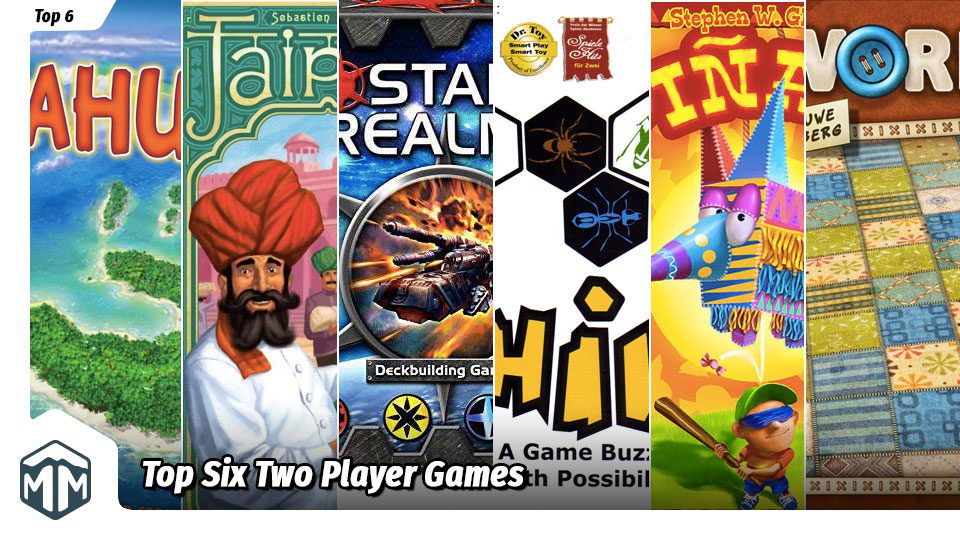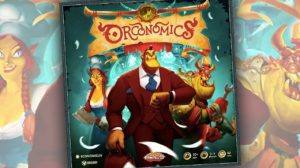I’d like to dedicate this review to a young man who doesn’t think he’s seen any good two player games today – Evan Leach, this one’s for you. 😀
Two player games have a long and storied tradition. For thousands of years men and women have been wrestling with that trickiest of questions.
There are only two of us, which game shall we play?
I’d like to think that if our ancestors had access to modern board games, they’d come up with a list very similar to the one you’re about to read. Sit back and enjoy the list…then immediately find your preferred opponent and go head to head with one of these games. As with my 6 Great Small Box Games to Bring on Trips article, this list is in no specific order. Remember that if you agree, or disagree, with my choices, let me know in the comments.
Kahuna by Günter Cornett
Kahuna is a game in the Kosmos 2 player line designed by by Günter Cornett and played over 3 rounds. It places the two players in a tropical paradise, fighting for control over a chain of islands. Each island is connected by a series of bridges which can be built, or destroyed, by each player as they vie for dominance. Control over an island (a majority) is gained by controlling the majority of bridges coming in to that island, and gaining a majority causes all of your opponents islands to be destroyed and fall flaming into the ocean. A companion deck of cards provides the means by which players build their web of bridges stretching out to the sandy beaches of each island.
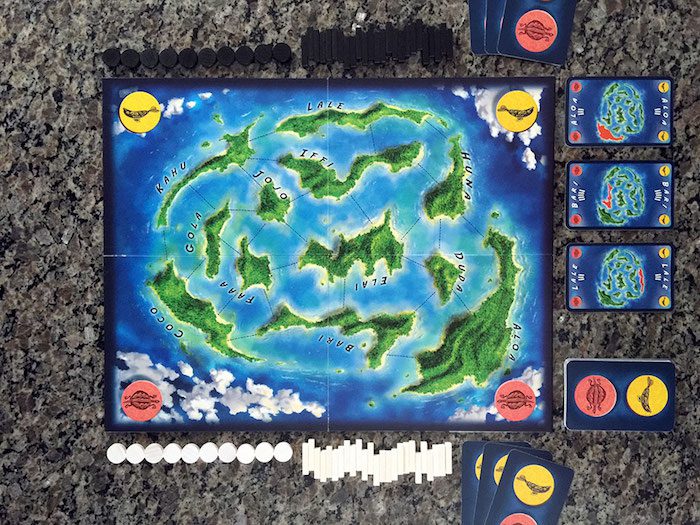
Kahuna rewards players who can think several moves ahead and anticipate their opponent’s plans. The art is beautiful, the box and components are well made and pleasing to play with, and the game is just great. If you enjoy abstract strategy games and tense gameplay where the tides can turn within a single move, then Kahuna is well worth your time.
Read my full review of Kahuna here.
Jaipur by Sébastien Pauchon
Jaipur is a smart, clever card game designed by Sébastien Pauchon and played over 3 rounds. In Jaipur players take on the role of traders desert marketplaces trying to exchange goods: gold, silver, gems, leather, spices, or cloth to curry the favor of the Maharaja. Players take turns drawing cards from the public marketplace, or by trading in existing goods for coins worth points at the end of the game. Clever players can also leverage additional favor by trading in multiples of one type of good. Players can also use camels found throughout the deck to help them plan ahead.

Jaipur is fun to play, fantastic to look at, and fun to rub in people’s faces when you beat them. It’s small and portable, and one of those rare card games that’s in the top 100 on BoardGameGeek. If you haven’t played Jaipur then you’re really missing out.
Read my full review of Jaipur here.
Star Realms by Robert Dougherty
Star Realms from Robert Dougherty is an superb deck building game in a tiny box. In Star Realms each player begins with an identical deck of cards containing attack type cards, and revenue type cards. 5 cards from a main Trade deck are laid face up between the players. Players then draw 5 cards to form their hand and the current player is able to purchase any number of cards from the Trade row that they can afford.
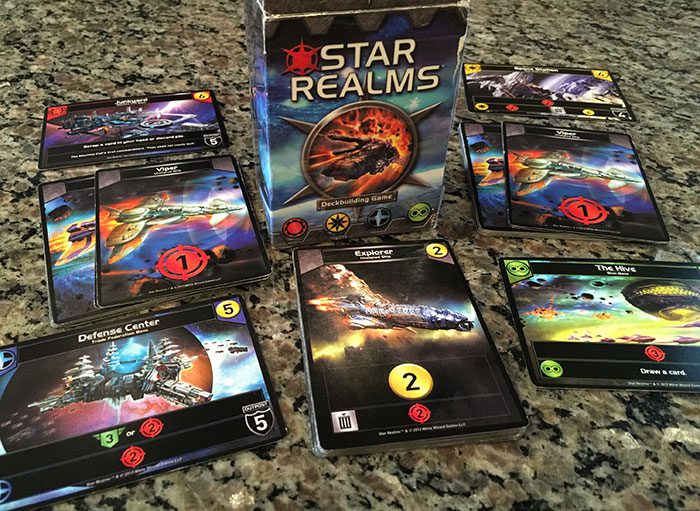
Cards in the Trade row are split into 4 factions each with a different specialty: damage, or income, or healing, etc. Unlike larger games such as Dominion, Star Realms doesn’t break cards up into distinct groups which can make it easier for experienced players to more easily work a path to victory. The cards in the Trade row are available for everyone to purchase, based on available income and personal choice.
Play proceeds between the two players until one player is able to reduce their opponent’s Authority (health) to 0 or below and wins the game.
Star Realms is that rare game where skill and experience can outweigh luck. It’s a wonderful game that is inexpensive, portable, varied, and easy to teach. The art is excellent, especially if you love pictures of imaginary spaceships (and who doesn’t). Star Realms is a good balance of strategy and luck, and it’s just plain fun to buy these outlandish ships and play them against your opponent. If you’ve never tried Star Realms, you owe it to yourself to give it a shot.
Hive by John Yianni
Hive by John Yianni turns the notion of chess on it’s earwig (see what I did there). A strategic tile based game very similar to chess, but using insects instead of 12th century concepts of nobility. In Hive players each control an army of bugs: ants, spiders, beetles, grasshoppers and even ladybugs, mosquitos and pillbugs (the latter 3 via expansions), all focused on a single task…protecting the queen bee.
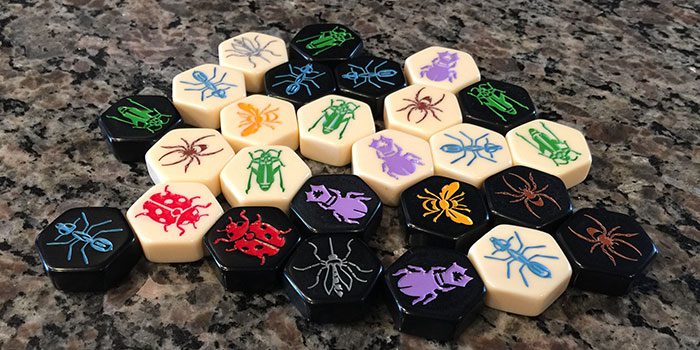
Hive doesn’t use a board; instead each hexagonal tile is placed onto the table in specific patterns, then moved on later turns. All of the pieces have their own movement patterns, like in chess, but Hive has the added benefit of being able to play in 3d as well. Ants are able to move anywhere around the outside of the next, while spiders can only exactly 3 spaces. Grasshoppers can jump over any number of pieces in a row, and beetles can actually clamber on top of adjacent pieces and trap the piece underneath them.
The goal of completely enclosing the enemy’s queen is made more difficult by the rule which states that at no time can the two Hives be disconnected. This means that at certain points of the game you’ll be forced to leave yourself vulnerable because your opponent has outmanuevered you.
Hive is a brilliant mind-bending game. It’s challenging and thinky, yet plays fast. The pieces are small but dense and heavy…they actuallly come in two sizes: standard in which the pieces are nearly two inches across, and pocket where the pieces are just under and inch. It’s such a unique game and so challenging mentally that it truly belongs in your collection…right between your copies of Ants in your Pants and Bedbugs.
Read my full review of Hive here.
Piñata by Stephen Glenn
Piñata is a fun-filled card game Stephen Glenn with some of the most fun wooden components you’ll ever see. In Piñata players attempt to collect randomly pulled candies from 4 “piñatas” located in the middle of the table. Five “hero of the party” medal cards are placed to the side, each of which has a color and a number. Each piñata card is double sided with a number and an arrow on it. The arrow indicates whether players must play high cards (the up arrow), or low cards (the down arrow). The number tells both players how many candies are placed on the piñata, which also dictates how many cards each player must play. Once the correct number (and color) of cards are played, the values of those cards are totalled. The player with the highest total (or lowest based on the piñata card side), wins all of the candies from that piñata.
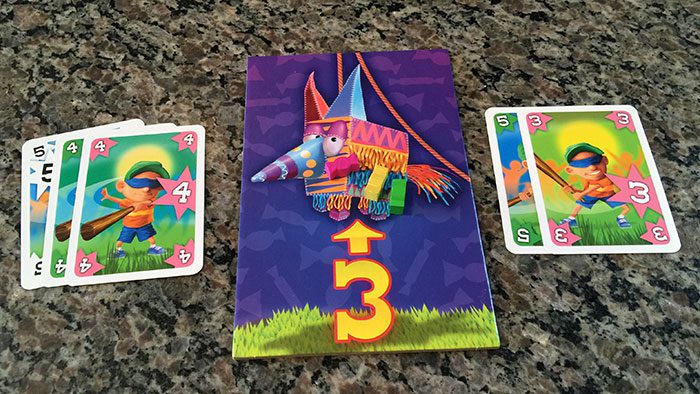
The piñata is then flipped to the opposite side, new candies are pulled from a bag, and the winning player determines if they quality for a “hero of the party” medal. If you have equal to, or greater than, the number of candies for that color medal then you take that medal and place it in front of you. The first player to collect 3 medal cards is the winner.
Piñata totally takes you back to that time in 3rd grade when Jeffrey Huggins busted open the piñata before you did and got a kiss on the cheek from Jodi Mayer. You were so jealous and…ummm…never mind. Piñata is a joy to play, and a delight to look at.
Read my full review of Piñata here.
Patchwork by Uwe Rosenberg
Patchwork by Uwe Rosenberg brings the world of competitive quilting to the tabletop. Think Tetris, combined with money, meets time management. If that sounds dry, relax because the game is anything but. In Patchwork players are competing to have the most evenly patch-covered quilt, earning “money” in the form of buttons with which to purchase their patches.
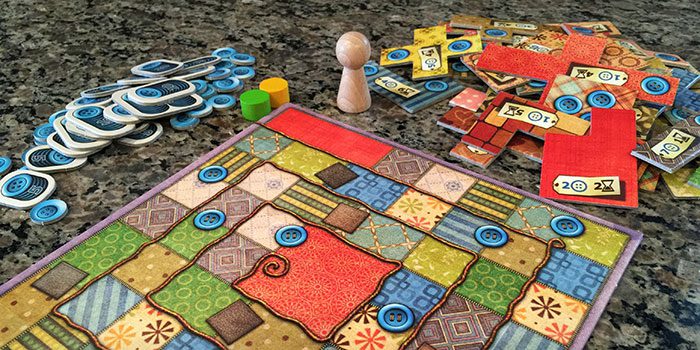
Each patch has a cost (to be paid in buttons), and a duration (how far along the time track you move your piece after taking that piece). The time aspect of Patchwork is what takes it off the rails. When you select a piece which moves you forward, your opponent is able to take as many moves as they like until they pass you, at which point its your turn again. So you better make sure your choice is the best one…but that’s easy too because at any point you can only choose from 3 patchwork pieces at a time, the ones directly in front of a tall tan marker piece.
Many patchwork pieces also have 1 or more buttons on them. Pieces with buttons earn you income each time you pass a button space on the scoreboard. Once both players have reached the end of the board, players get one last income, then tally up their scores. Any open spaces on your board are worth -2 points. The player with the highest score wins.
Patchwork has very little interaction between the players, other than a player possibly blocking another player, or taking a piece that player wanted. It’s more like competitive Tetris than anything else. But the addition of the income, and the time tracker mechanisms truly make Patchwork a unique game. Don’t be fooled by the theme, this is a wolf hiding under a quilted blanket.
Honorary Mentions
These games belong in this list, but didn’t quite make the top six.
Tides of Time
Tides of Time is a great micro card drafting game thats inexpensive, plays fast (10-15 minutes or so), and has some of the most beautiful game art you’ll ever see.
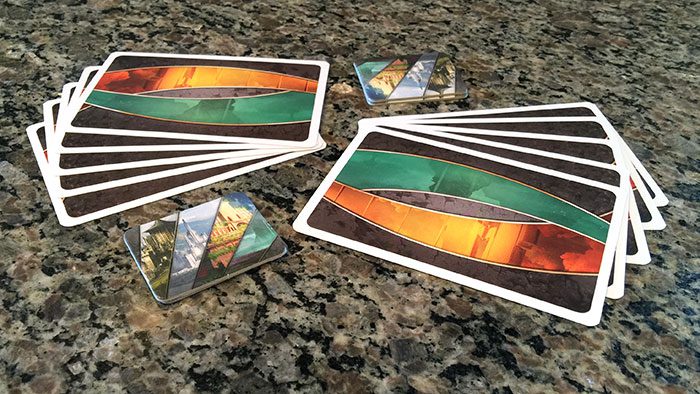
Read my full review of Tides of Time here.
Agricola: All Creatures Big and Small
Agricola: All Creatures Big and Small is a “gamers” two player game. Deep with decisions, multiple paths to victory, and some of the most wonderful wooden pieces. All in an 8 inch square box. The “little brother” to Agricola, Agricola: All Creatures Big and Small focuses solely on the animal husbandry aspect of the farm and allows players to raise and breed pigs, sheep, cows and horses, and build up buildings which support those animals. All of this in only 8 turns. If both you and your partner of choice like deeper games, then this one should be on your list.
Mancala
Yes, this game is old, but it’s excellent, and one whose main mechanic has been copied over and over. Think Airplanes, Five Tribes, and Longhorn to name a few. It’s easy to teach, pretty portable, and people of all ages can play it. In fact it’s actually my most played game of all time, simply because my kids and I can play a game in just a few minutes. It teaches counting, logical thinking, and strategy and should be in every gamer’s library.


